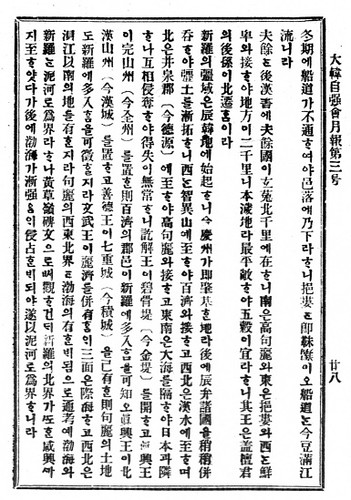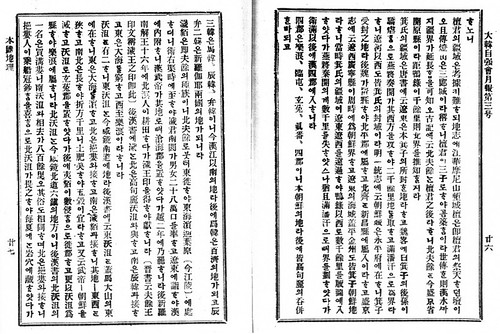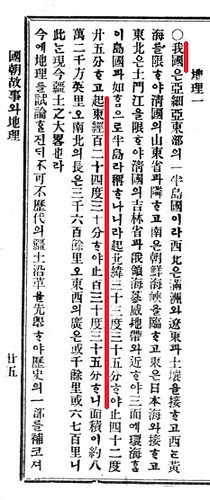 In 1906, one of the leading organizations of Patriotic Enlightenment Movement for the restoration of the sovereign right of the nation, “the Korean Self-Strengthening Society (大韓自强會)”, was founded by Jang Ji-yun(張志淵) and others. They published 13 edition of monthly magazines from July 1906 to July 1907. Interestingly, the front pages of those magazines are same and features Korean territory in red, blotting out Takeshima/Dokdo from her territory.
In 1906, one of the leading organizations of Patriotic Enlightenment Movement for the restoration of the sovereign right of the nation, “the Korean Self-Strengthening Society (大韓自强會)”, was founded by Jang Ji-yun(張志淵) and others. They published 13 edition of monthly magazines from July 1906 to July 1907. Interestingly, the front pages of those magazines are same and features Korean territory in red, blotting out Takeshima/Dokdo from her territory.Moreover, the chapter of the Korean geography printed in the 3rd edition of the magazine published on July, 1906, clearly states that the eastern limit of Korean territory is 130º 35' E. longitude.
Remember that Jang Ji-yun was the president, the publisher and the editor in chief of Hwangseong Shinmun(皇城新聞). Its May 9 1906 article reported that 1906, Mar. 25, Uldo Prefect Governor Shim Hung-taek(沈興澤) reported that Japanese incorporated “Dokdo(獨島)” (note that he didn’t report Seokdo/石島) which locate "外洋百里(40km far in the open sea). And in a July 13, 1906 article clarified that the Korean government in 1906 did not recognize "Dokdo" (Liancourt Rocks) as being part of Uldo County (Ulleungdo), even though the government had just recently gotten a report on "Dokdo" from Shim.
This coincide with this Korean Self-Strengthening Society’s monthly magazine cover illustration of Korean Territory. It is crystal clear that Korean didn’t recognize Takeshima/Dokdo as its territory, at the time Korean got to know Japan’s incorporation in 1906. Apparently, Shim’s report was mistake and “獨島” was not “石島”, which today’s Korean claim as another name of Dokdo back then. In conclusion, 石島 in 1900’s Korean Imperial Edict No.41 (大韓勅令第41号) was not Japan’s Takeshima and Korean didn’t recognize Takeshima as its territory based on Korea’s own historical documents.
In 1907, Jang published "New Topography of Great Korea(大韓新地誌)". Its chapter of "location" states that Korea's eastern border is Tumen River and it is 130º 58' E. longitude. As for Ulleungdo, Jan wrote, that Uleung Island locates from 130º 45' N. to (130º) 35' N. and from 37º 34' E. to (37º) 31' E. (Probably the mistake for 130º 45' E. to (130º) 53' E. and from 37º 34' N. to (37º) 31' N. ) The states that Uleung island can be seen (from Korean peninsula) on a clear fine day. It also says that Usando exists to the south-east of the island. However, the map attached to the book also blotted out Takeshima/Dokdo from its "The Map of Korea(大韓全図)" and "The Map of Gyeongsangbuk-do(慶尚北道)" as well. On top of that, "The Map of Gyeongsangbuk-do(慶尚北道)" depicts Jukdo(竹島, not Japan's Takeshima) precisely on the location of Jukdo. From those historical documents, whatever the Usando Jan added really was, it is apparent that he considered Korea's easternmost was Ulleungdo and today's Takeshima/Dokdo was outside of Korean territory.
"The attatched map of The New Topography of the Great Korea (大韓新地志附地圖)" (The National Library of Korea's site)


